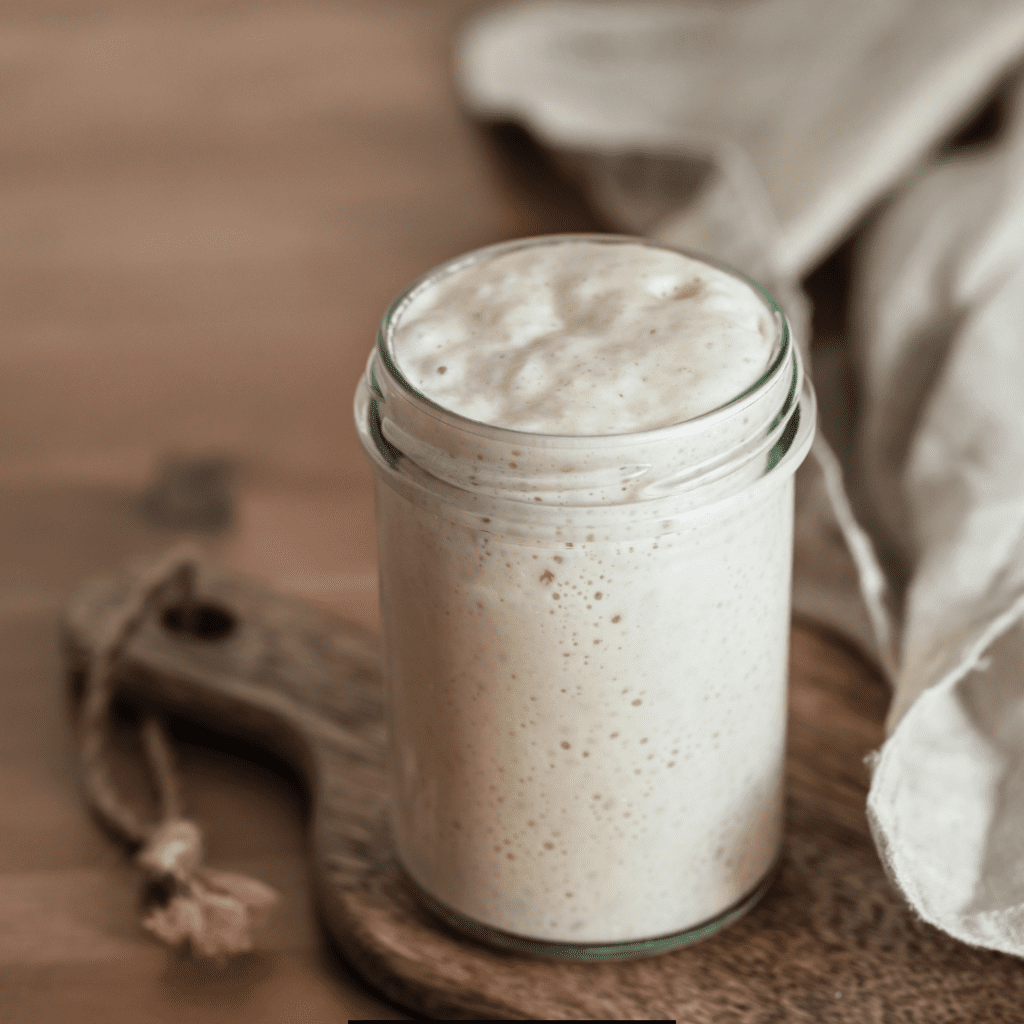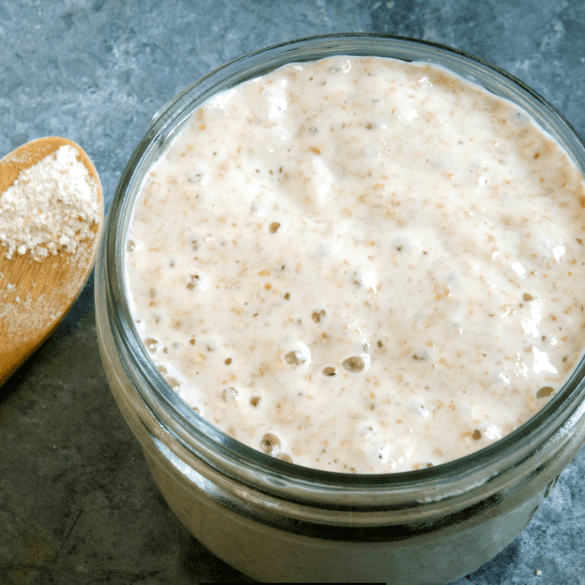For many of us, baking sourdough at home became a symbol of comfort and resilience, especially when the world outside seemed uncertain. I, too, found solace in the rhythmic routine of feeding my starter, watching it double in size and the joy of that tangy aroma filling my kitchen as my bread baked to perfection. It’s a testament to how, with a little love and patience, we can create something wonderfully fulfilling from the most basic elements.
In this article, we will check out the ins and outs of creating your very own sourdough starter from scratch.
How to make Sourdough Starter from Scratch
Sourdough starter from scratch is a naturally fermented mixture of flour and water that captures wild yeast and beneficial bacteria from the environment. This starter serves as a leavening agent for sourdough bread, providing a distinctive flavor and texture.
Ingredients
- Flour: While you can use all-purpose flour, whole wheat or rye flour is often recommended to initiate your starter as they lead to quicker fermentation due to their higher nutrient content. As your starter becomes established, you can experiment with different types of flour to see how it affects the flavor and activity of your starter.
- Water: Use filtered or dechlorinated water to ensure that no chemicals inhibit the fermentation process. The water should be at room temperature to create an ideal environment for the wild yeast and bacteria.
Instructions for Creating Your Sourdough Starter from Scratch
Day 1:
- Mix: In a clean jar or container, combine 100g of flour with 100ml of water. Stir vigorously until you have a thick, homogenous mixture. This will be the foundation of your starter.
- Cover: Cover the container with a cloth or loosely with a lid to allow the mixture to breathe while keeping pests and dust out.
- Rest: Set the container in a warm spot (around 68-75°F or 20-24°C) away from direct sunlight.
Day 2-5:
- Feed: Each day, you must feed your starter with fresh flour and water. Remove and discard about half of the starter from your jar (around 100g), and then add 100g of flour and 100ml of water to the jar. Stir thoroughly.
- Cover and Rest: Repeat the covering and resting process as on Day 1.
- Note: Around day 2 or 3, you should start seeing bubbles in your mixture, and it may have a slight rise. This is a sign of activity, but it may subside—it’s normal. Your starter is developing its colony of wild yeast and bacteria.
Day 6 and Beyond:
- Continue with the feeding process. As your starter becomes more active, it should double in volume within 4 to 6 hours of feeding. The texture will be light, spongy, and filled with bubbles. It’s now ready to be used for baking.
Tips for a Successful Sourdough Starter from scratch
- Consistency: Try to feed your starter at the same time each day. Consistency helps in strengthening your starter.
- Observation: Pay attention to the smell and appearance of your starter. A healthy starter has a pleasant sour smell and lots of bubbles.
- Patience: Don’t rush the process. Developing a strong and active starter can take time. Some starters may take longer to show signs of vigorous activity.
- Feeding Ratio: As your starter matures, you might adjust the feeding ratio depending on how quickly it rises and falls.
- Use It or Store It: Once established, if you don’t plan on baking regularly, you can store your starter in the refrigerator and feed it once a week to maintain it.
Ingredients Substitutes

Creating a sourdough starter from scratch is a flexible and forgiving process. While the basic ingredients are simple—flour and water—the type of flour you use can vary based on what you have on hand, your dietary preferences, or the flavor profile you’re aiming to achieve in your sourdough bread.
Flour Substitutes
1. Whole Wheat Flour
Original Ingredient: Often recommended for starting due to its high nutrient content.
Substitute: If whole wheat is not available, you could start with all-purpose flour, understanding that the fermentation may kickstart a bit more slowly.
2. Rye Flour
Original Ingredient: Renowned for its ability to quickly ferment, making it an excellent choice for a lively starter.
Substitute: If rye flour is hard to come by, substituting it with whole wheat flour is a good choice, as it also has a high nutrient and mineral content beneficial for yeast and bacteria.
3. All-Purpose Flour
Original Ingredient: Accessible and commonly used, yet less nutrient-rich compared to whole wheat or rye.
Substitute: If you’re seeking a more robust flavor and quicker fermentation, using a percentage of whole wheat or rye flour mixed with your all-purpose can give your starter a boost.
4. Gluten-Free Flour
Original Ingredient: Not traditionally used due to the lack of gluten, which impacts the structure and rise of sourdough bread.
Substitute: For those needing a gluten-free option, buckwheat, brown rice flour, and a mix of gluten-free flours can be used. Note that the texture and behavior of the starter might differ, and it may require more frequent feedings due to the different fermentation rates.
Water Substitutes
1. Filtered Water
Original Ingredient: Recommended to avoid chlorine and other chemicals found in tap water, which can inhibit yeast and bacterial growth.
Substitute: If filtered water is unavailable, letting tap water sit out overnight before use can help dissipate chlorine. Alternatively, bottled spring water can be a good substitute.
2. Non-Chlorinated Water
Original Ingredient: The best option to ensure that beneficial bacteria and yeast are not harmed.
Substitute: Boiled and cooled tap water can sometimes be used as a makeshift substitute, as boiling can remove some chemicals, though it might not be as effective as filtered or spring water.
Final Thoughts
Creating a sourdough starter from scratch is a rewarding process that connects you deeply to your food and its origins. Remember, each sourdough starter is unique, developing flavors influenced by its environment, the flour you use, and your care.
More Baking Recipes:
- Homemade Biscuits with All-Purpose Flour
- Oven Baked Chicken Cutlets (No Breading)
- How to Bake Pumpkin Seeds

Ingredients
- Flour
- Water
Instructions
Day 1:
- Mix: In a clean jar or container, combine 100g of flour with 100ml of water. Stir vigorously until you have a thick, homogenous mixture. This will be the foundation of your starter.
- Cover: Cover the container with a cloth or loosely with a lid to allow the mixture to breathe while keeping pests and dust out.
- Rest: Set the container in a warm spot (around 68-75°F or 20-24°C) away from direct sunlight.
Day 2-5:
- Feed: Each day, you must feed your starter with fresh flour and water. Remove and discard about half of the starter from your jar (around 100g), and then add 100g of flour and 100ml of water to the jar. Stir thoroughly.
- Cover and Rest: Repeat the covering and resting process as on Day 1.
- Note: Around day 2 or 3, you should start seeing bubbles in your mixture, and it may have a slight rise. This is a sign of activity, but it may subside—it's normal. Your starter is developing its colony of wild yeast and bacteria.
Day 6 and Beyond:
- Continue with the feeding process. As your starter becomes more active, it should double in volume within 4 to 6 hours of feeding. The texture will be light, spongy, and filled with bubbles. It's now ready to be used for baking.
